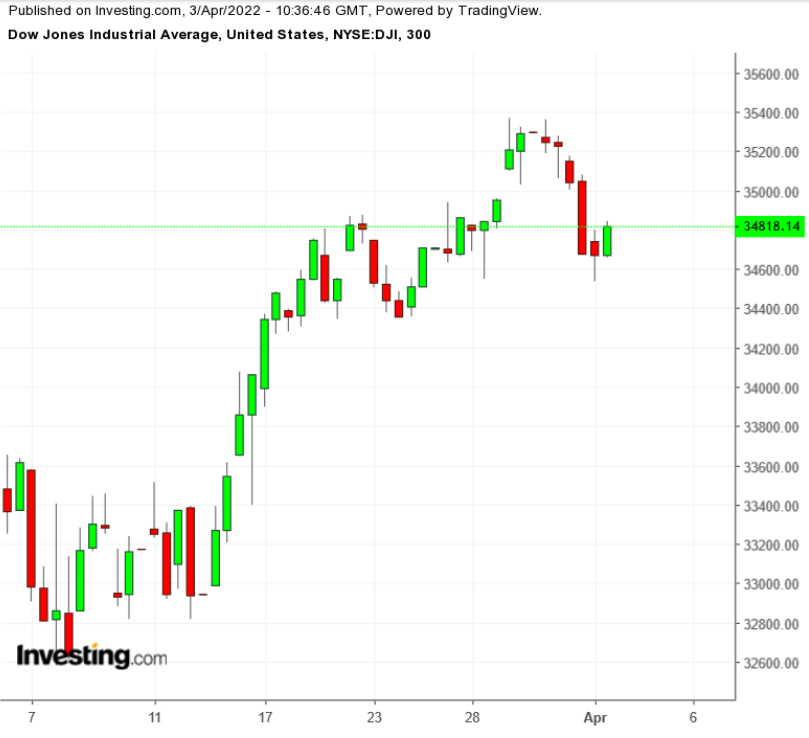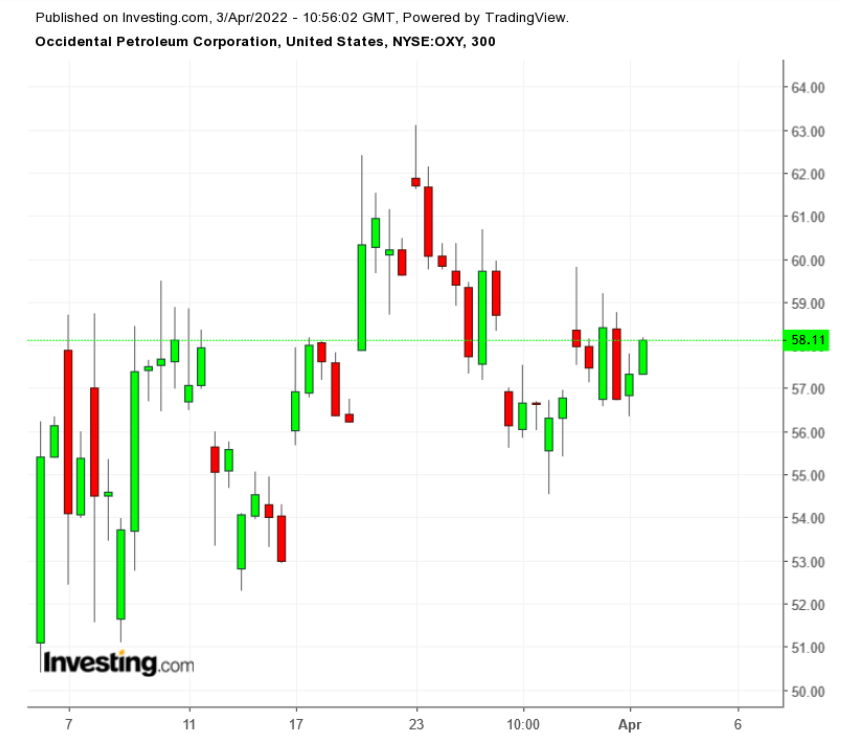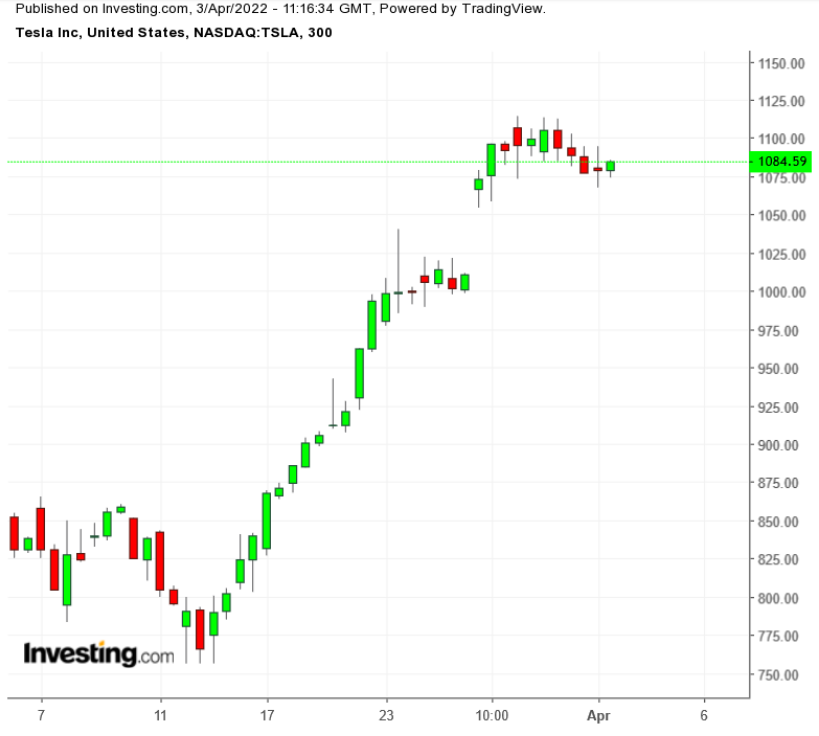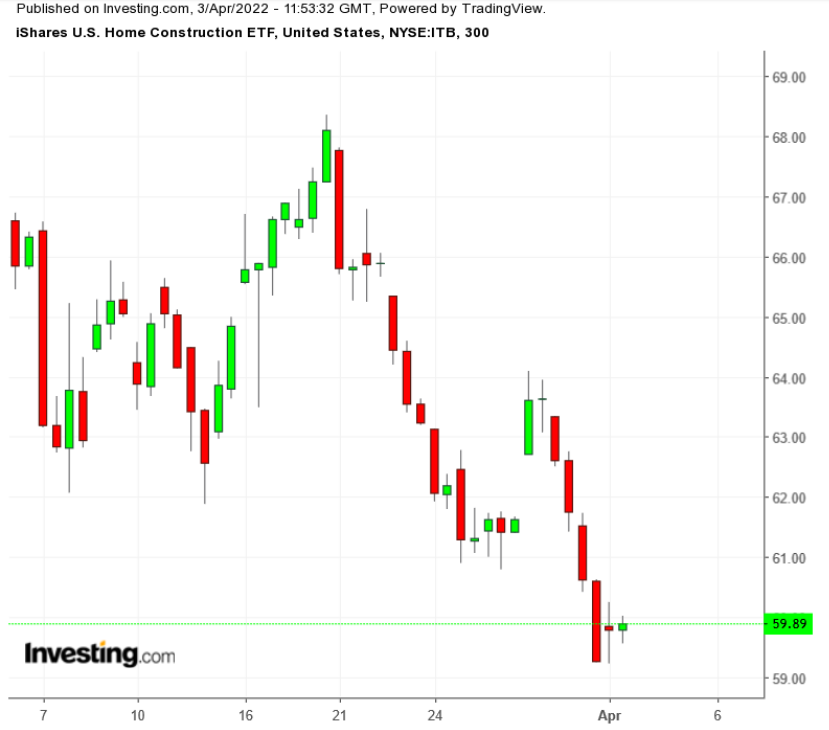Stocks finished higher in March after two months of losses at the start of 2022.
It was a chaotic month as stocks rebounded from the selloff that began at the very end of 2021 and slumped as much as 20% into mid-March. The declines were triggered by the Federal Reserve's decision, signaled in November, to raise interest rates in order to bring inflation under control.
And then Russia invaded Ukraine on Feb. 24.
The rebound from the mid-March lows was enough during the early part of last week for a few analysts to proclaim it was the start of a new bull market.

But the close at the very end of March, when the Dow Jones Industrial Average fell 550 points called that bullishness into question.
End Of Month Gains Not Enough To Boost Indices For The Quarter
To be sure, the US economy is growing steadily. Friday's monthly nonfarm payrolls report was steady if not spectacular. However, the unemployment rate of 3.6% was the lowest for that metric since December 2019.
The best one can say about markets going forward is that there's a good chance of making some money. But expect continued volatility with an array of headwinds potentially able to derail a winning streak at any time:
- The Ukraine incursion and its impacts—easily seen though not necessarily so easily appreciated.
- The Fed and its inflation-fighting campaign and worries of an approaching recession.
- Continuing supply chain woes, whether COVID-19 related or otherwise.
At the close of the month's trading on Mar. 31, the S&P 500 Index had gained 3.6% for the month. The Dow added 2.3% over the same period, and the NASDAQ Composite climbed 3.4%. Between its Mar. 8 closing low and its Mar. 31 finish, the SPX jumped 8.6%, with the Dow up 6.3% at the same time. The NASDAQ's gain from its Mar. 14 closing low was 13%,
The end-of-March rebound wasn't enough to push the indices into the black for the first quarter. The S&P 500 was down 4.95%, its first down quarter since 2020 when the pandemic erupted. The Dow fell 4.6%, and the NASDAQ shed 9.1%. Both had also slipped during the third quarter of 2021.
Ukraine-Russia Effects
The impact—not to mention the risks—of the Ukraine-Russia war cannot be understated.
The conflict has pushed oil prices substantially higher.
West Texas Intermediate crude jumped 33% in the quarter, with the May contract closing at $100.28. Oil peaked at $123.70 a barrel in early March. But the Biden Administration's decision to sell crude out of the Strategic Petroleum Reserve has knocked the price down to around $100 a barrel.
Retail gasoline prices have been jumping since last year. The American Automobile Association's Daily Fuel Gauge report said retail gas prices nationally were up 17% in March and 28.6% for the quarter. And 14% for 2021.
No surprise then that Energy was the top performing S&P 500 sector in the first quarter, up 37.7% for the period, gaining 8.9% in March. Occidental Petroleum (NYSE:OXY) was the third best S&P stock in March, up 29.8%.

Indeed, nine of the top 10 S&P 500 stocks for the quarter were energy stocks. Occidental was the leader, up 95.7%. Others included Halliburton (NYSE:HAL), up 65.6%, APA Corporation (NASDAQ:APA), +53.7%, and Marathon Oil (NYSE:MRO), up 52.9%. Chevron (NYSE:CVX), up 13.1% in March and 38.8% for the quarter, led the Dow.
The conflict has also raised food prices globally. Together, Russia and Ukraine provide about 30% of global wheat exports. At $10.06 a bushel on Thursday, wheat had jumped 7.7% in March, gaining 30.6% in the quarter.
The Russian military has been trying to forcibly 'reacquire' Ukraine, which declared its independence from the old Soviet Union in 1991. Despite global consensus—not to mention Russian President Vladimir Putin's personal opinion—prior to the invasion assuming Russia's military would make quick work of any Ukrainian defenses, the Ukrainian military, along with its citizenry have been waging a spirited defense even as millions of Ukrainians have fled to Poland, Moldova and elsewhere.
But the known unknowns are terrifying. The great fear is that the conflict will spread beyond Ukraine to Poland, Estonia, Lithuania and Latvia. Putin has made veiled threats about using nuclear weapons. There's also been talk about chemical warfare.
Conversely, there's also opportunity available because of the conflict.
Investors want certainty and/or predictability. In addition, there's Russia's extensive capabilities in waging cyber-warfare.
As such, cyber-security and data analytics stocks were the big winners in March. Splunk (NASDAQ:SPLK), Verisk Analytics (NASDAQ:VRSK) and CrowdStrike Holdings (NASDAQ:CRWD) each jumped more than 20% during the month and were among the top performers on the NASDAQ 100.
Palo Alto Networks (NASDAQ:PANW), a prominent player in cyber-security, was up 4.8% in March, after a 14.9% gain in February. For the quarter, PANW is up 11.8%.
High Profile Splits
Another big gainer in March was electric vehicle maker Tesla (NASDAQ:TSLA) whose shares surged 23.8% during the month after dropping 7.1% in February.

The rebound is due in part to rising fuel prices along with the EV company's decent fourth quarter results. Add bonus: the company floated a proposal to split its shares for the second time in two years.
The size of the split isn't clear, but after the 5-for-1 split in 2020, the stock has more than doubled. In addition, Tesla said Saturday it delivered 310,000 vehicles globally in the first quarter, up 68% from a year ago—but flat versus the fourth quarter because of supply-chain problems.
If the split occurs, Tesla would be joining a number of mega caps planning to split their shares including Amazon, which announced a 20-for-1 split in March, and Alphabet, which announced a 20-for-1 split in early February.
Powell's Challenge At The Fed
The Federal Reserve, led by Chairman Jerome Powell, has contributed mightily to this year's market volatility after the pandemic disrupted life as we know it. Prices after the spring 2020 market panic and the reopening of the US economy, accelerated, were made worse by global supply chain woes.
US CPI in February was up nearly 8% YoY. The Commerce Department's PCE Price Index for February was up 6.4% from a year earlier, the biggest gain since January 1982. The PCE is what Fed policymakers watch most closely.
This escalation is forcing the Fed to boost interest rates in an effort to cool off the US economy. That sounds good except stocks typically fall if rates go up too quickly.
In November, the Fed said it would be raising rates this year and beyond. The first rate increase came on Mar. 17 and signs from the Fed indicate there will be more quarter-point rate increases this year, perhaps as many as six. That would bring the Fed's key interest rate close to 2% by the end of the year with more increases expected in 2023.
Also escalating in March was the 10-year Treasury yield, a key determinant in setting mortgage rates. The 10-year yield moved from 1.45% when the Fed signaled its plans to hike rates on Nov. 5 to more than 2.2% during March, a gain of 60%.
The risk—as many financial commentators are suggesting—is that the Fed will go too far too fast, causing a recession. The bond market is already signaling its worries via the yield curve inversion of 2-year spread 10-year Treasuries.
Normally, the yield on the 10-year is higher than that of the 2-year, reflecting the risks of holding a bond with a longer term to maturity. But on Mar. 31, the two-year Treasury yield was about 2.4% while the 10-year yield was about 2.33%. This is what's called a rate or yield inversion.
Fed critics are saying these signs signal a recession is ahead. A yield inversion formed in 2000 ahead of the dotcom bust and again in 2006-2007 before the Great Recession. And historically, rarely has the Fed achieved what they call a soft-landing: lower prices (or smaller increases) and no recession.
Still, a yield inversion doesn't indicate when a recession might arrive. It could be years, in fact. Nor does it provide any clues regarding how bad the recession will be—or how long it might last. Nonetheless, everyone is having to cope with higher prices. It's a big reason mortgage brokers are currently begging customers to refinance. They fear higher rates will choke off the recent, highly active housing market, and crack the feverish uptrend in home prices.
This explains why real estate and home building shares are lower this year. The iShares US Home Construction ETF (NYSE:ITB) invests primarily in home builder stocks.

The ETF fell 28.5% in the first quarter and 11.3% in March. The ETF was up 48.6% in 2021.
Big Tech Less Frothy
Energy and Utilities were the only S&P 500 sectors to have positive first quarters. Financial sector stocks struggled, though higher interest rates should improve their results.
Big tech shares—the pandemic darlings—muddled along, acting as a drag on a variety of indices and the market overall. The Technology sector represents 28% of the S&P 500 alone. Apple (NASDAQ:AAPL) and Microsoft (NASDAQ:MSFT) each make up about 9% of the broad benchmark's total market cap.
Apple was up 5.8% in March but off 1.7% for the quarter. Its market cap nearly climbed back over $3 trillion (where it was in January), before slumping lower on Thursday. Microsoft rose 3.2% in March but was off 8.3% for the quarter.
Google-parent Alphabet (NASDAQ:GOOGL) added just 3% in March but was -4% for the quarter. Amazon (NASDAQ:AMZN) rose 6.1% because of its announced stock split but slid 2.2% for the quarter.
Will There Be A Breakout Any Time Soon?
The short answer: when (and if) the Ukraine-Russia conflict ends and there's progress on inflation. No one can predict the first point. As for inflation, that depends on how high the Fed raises rates and when it decides it has bested inflation. Maybe at the end of 2023.
Three additional risks are hovering—a polarized political environment heading into November's mid-term elections and the presidential election in 2024; plus whether the next COVID-19 variant turns out to be benign or dangerous. And finally, keep an eye on US-China relations.
Taking those questions off the table, the US economic fundamentals are still in place for a stable-to-growing economy. And employers are actively looking for workers. They're even paying up to get them.
US stability is still a draw in an uncertain world. You can see that via the US Dollar Index, up 3% this year versus a basket of other major currencies.
If one is a chart watcher, expect a range-bound scenario for markets this year and next, with the S&P 500 trading between 4,300 and 4,800. One thing is certain, you can't fight the Fed when the central bank is hiking rates. You can only watch economic internals carefully and hope they're doing the same.
Which stock should you buy in your very next trade?
AI computing powers are changing the stock market. Investing.com's ProPicks AI includes 6 winning stock portfolios chosen by our advanced AI. In 2024 alone, ProPicks AI identified 2 stocks that surged over 150%, 4 additional stocks that leaped over 30%, and 3 more that climbed over 25%. Which stock will be the next to soar?
Unlock ProPicks AI